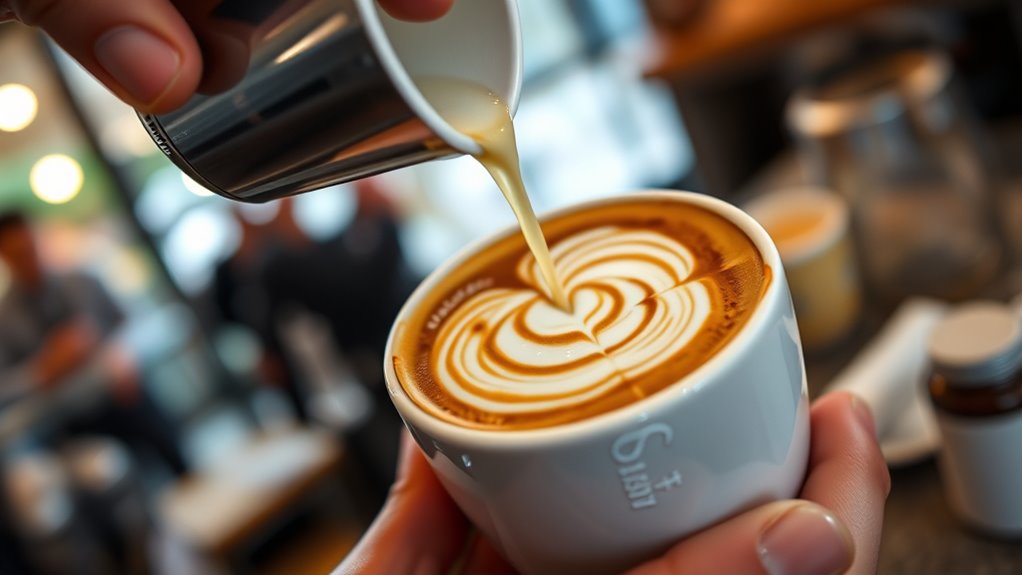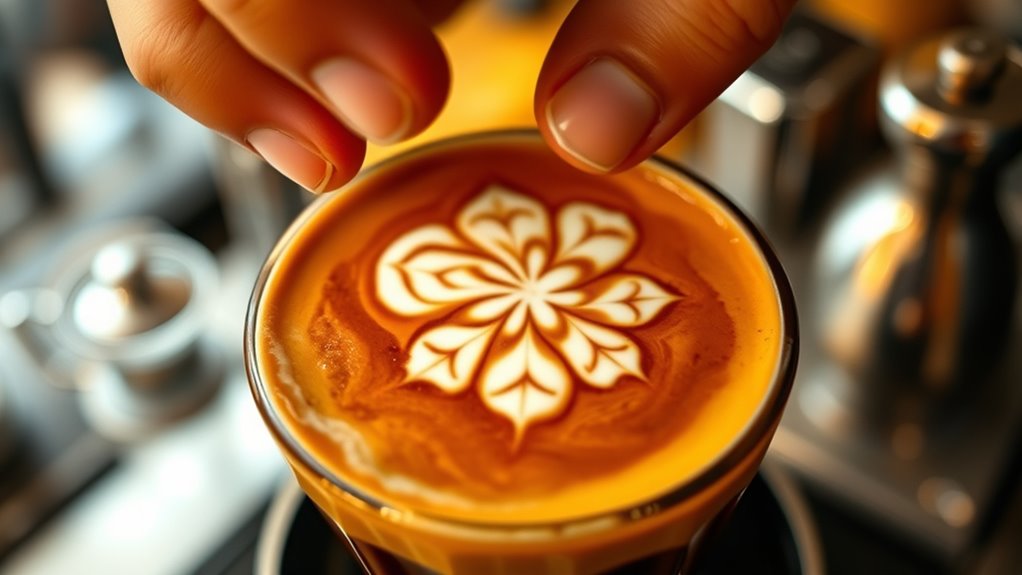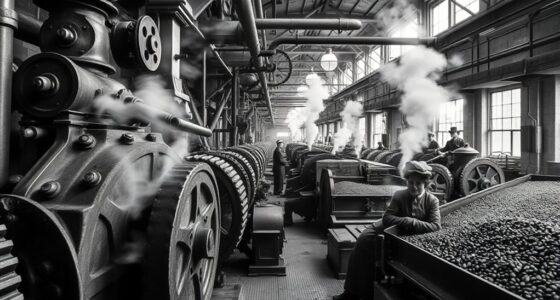Latte art started in Italy during the early 1980s as baristas sought to showcase their skill and creativity beyond just making espresso. They experimented with pouring techniques to create beautiful patterns like hearts and rosettas in milk foam. Over time, these artistic skills spread worldwide, transforming into a global coffee phenomenon. If you want to discover how this art form evolved and became a symbol of craftsmanship and innovation, keep exploring the fascinating journey of latte art.
Key Takeaways
- Latte art originated in early 1980s Italy, emphasizing artistic presentation alongside high-quality espresso.
- Baristas developed techniques like pouring shapes such as hearts and rosettas to create visual designs.
- The craft spread internationally, becoming a symbol of mastery in global coffee culture.
- It evolved from simple patterns to elaborate designs, reflecting technical skill and artistic expression.
- Today, latte art is a key element of modern coffee culture worldwide, showcasing creativity and craftsmanship.

Latte art has become a popular way to showcase baristas’ skills and add aesthetic appeal to your coffee experience, but its origins trace back to the early 1980s in Italy. During this period, the Italian coffee culture was flourishing, emphasizing high-quality espresso and the artistry behind each cup. It was in this vibrant environment that baristas began experimenting with pouring techniques, transforming simple coffee into a canvas for artistic expression. The development of latte art was driven by a desire to elevate the coffee experience, making each cup not just a beverage but a visual delight. These early efforts incorporated artistic techniques that involved skillful pouring, creating patterns and shapes directly in the milk foam. As coffee shops and cafes grew more competitive, baristas sought new ways to impress customers, leading to a focus on aesthetic presentation. The Italian approach to coffee culture emphasized craftsmanship, and latte art became a natural extension of this ethos, combining technical mastery with creative flair.
Over time, the techniques evolved beyond Italy’s borders, spreading across Europe and eventually reaching the United States and Asia. What started as a niche skill among Italian baristas soon turned into a global phenomenon. The artistic techniques involved in latte art are deceptively simple yet require precise control over the milk’s texture and pouring speed. You learn to manipulate the flow to create intricate patterns such as hearts, rosettas, and tulips, each requiring steady hands and practiced finesse. As more baristas refined their skills, the art form grew more complex, with some pushing the boundaries into more elaborate designs and even three-dimensional sculptures. The international coffee community embraced these innovations, turning latte art into a symbol of barista expertise and creativity.
Today, latte art is a essential part of coffee culture worldwide. It’s not just about making coffee look beautiful; it’s about expressing artistry through a carefully executed set of techniques. Whether you’re a barista or a coffee enthusiast, understanding the origins of latte art reveals how a simple act of pouring milk can become a form of personal and cultural expression. Its journey from Italy’s cafes to global stages underscores how artistic techniques in coffee preparation can elevate a daily ritual into an art form. This evolution continues as new generations experiment with styles and methods, ensuring that latte art remains a dynamic, engaging aspect of the coffee experience.
Frequently Asked Questions
When Did Latte Art First Become Popular Worldwide?
You’ll find that latte art gained worldwide popularity in the early 2000s, thanks to the rise of specialty coffee culture. As baristas underwent training to perfect their skills, they showcased intricate designs, making coffee a visual experience. Coffee shops around the globe embraced this trend, turning latte art into a symbol of quality and craftsmanship. You can see its influence now in cafes everywhere, elevating your coffee experience.
Which Country Pioneered Modern Latte Art Techniques?
European countries, especially Italy and the UK, pioneered modern latte art techniques. European baristas played a key role in developing intricate pouring styles and designs, influenced by rich coffee culture. They experimented with milk textures and pouring methods, transforming latte art from simple patterns to an art form. Your appreciation for coffee artistry stems from this innovative European tradition, which has now become a global phenomenon, inspiring baristas worldwide.
What Equipment Is Essential for Practicing Latte Art?
Practicing latte art is like painting with coffee, and you’ll need a few essential tools. Start with a good espresso machine that has a steam wand for milk frothing, which creates silky, textured milk. A stainless steel pitcher helps you control pouring techniques, and a thermometer ensures perfect temperature. Finally, a steady hand and patience are your secret weapons to master the beautiful patterns that make latte art so mesmerizing.
Are There Specific Milk Types Best Suited for Latte Art?
You should choose milk with a smooth, velvety milk texture for the best latte art. Whole milk is ideal because its fat content helps create stable microfoam, making it easier to pour intricate designs. Keep the milk at a temperature of around 140°F to 150°F, as this guarantees ideal milk texture and flow. Avoid overheated milk, which can ruin the microfoam and make pouring difficult.
How Has Social Media Influenced Latte Art Popularity?
Social media has turned latte art into a global stage, making it as easy as scrolling to become inspired. You’re likely to see trending designs and innovative techniques through social media trends, which motivate you to practice and perfect your craft. Online barista communities connect you with experts and enthusiasts, offering feedback and ideas. This digital exposure fuels your passion, transforming simple milk into art that captivates and shares across the world.
Conclusion
As you savor that delicate swirl of foam, remember it’s more than just art—it’s a story etched in milk, symbolizing the journey from humble Italian cafés to worldwide recognition. Each pattern reflects creativity and connection, reminding you that even simple ingredients can create something beautiful and meaningful. So next time you see latte art, see it as a canvas of history, passion, and shared moments waiting to be discovered in every cup.








